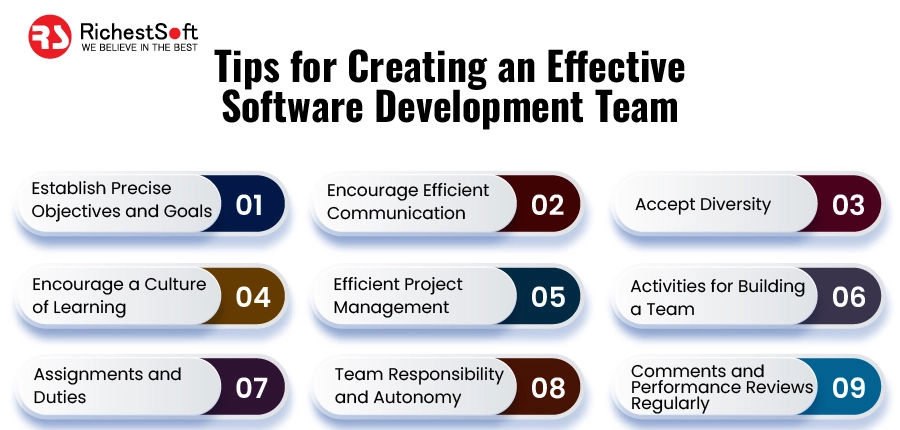Software development has grown into the core component of creativity and achievement for firms across many industries in today’s quickly evolving digital economy. An efficient software development team is crucial to boosting profitability and effectiveness and eventually achieving corporate objectives. It is establishing well-built software solutions, optimizing company procedures, or developing cutting-edge apps.
Understanding how to build a software development team involves more than just putting together a competent collection of people. It necessitates thorough preparation, deliberate thought about roles and duties, and the application of tactics that promote cooperation, communication, and ongoing development. In this post, we’ll look at some helpful hints, examine the structure and functions of a software development team, or offer suggestions on how to form and run a successful team.
Tips for Creating an Effective Software Development Team
✅Establish Precise Objectives and Goals
Set particular targets and ambitions to obtain any software development team. Doing this will coordinate the team’s efforts, and everyone will work toward the same goal. To promote a sense of unity among the team members, clearly describe the project’s parameters, due dates, and anticipated results.
✅Encourage Efficient Communication
Any team needs effective communication, but in the context of software development, this is especially true. Promote channels for dialogue that are clear and transparent among team members as well as with stakeholders. Project administration tools, stand-ups, and frequent team conferences can improve cooperation and communication.
✅Accept Diversity
A varied staff offers a variety of viewpoints and experiences, which results in more creative solutions. Encourage variety throughout your software development group’s skill sets, histories, and experiences. Thanks to this variety, the team can tackle problems from various perspectives and come up with original solutions.
✅Encourage a Culture of Learning
Software development is a field that is expanding all the time. It’s crucial to stay up to date with novel methods and practices. You may encourage a learning culture inside the team by offering professional growth opportunities, promoting knowledge exchange, and allotting time for exploring and experimenting.
✅Efficient Project Management
Implement efficient project administration techniques to guarantee efficient operation and prompt delivery. To improve communication, measure progress, and oversee project timeframes, use managing projects tools and strategies, including Agile methodology, Scrum panels, and task management programs. Based on the group’s and project’s demands, periodically examine and modify your project handling strategy.
✅Activities for Building a Team
Activities during team-building initiatives strengthen team relationships. Encourage social engagements and provide teammates with chances to interact personally. Work-building exercises that foster trust, cooperation, and a supportive work environment might vary from casual get-togethers and trips to more formal collaborative events.
✅Assignments and Duties that are Clear
The duties and obligations of every team member should be appropriately stated and communicated. Clarity is confirmed to ensure everybody knows their unique contributions and prevent confusion and work repetition. Additionally, well-defined responsibilities encourage accountability and facilitate effective team coordination.
✅Team Responsibility and Autonomy
Encourage a culture of independence and empowerment among the team members. Give team members the flexibility to decide for themselves and take responsibility for their job. Encourage them to provide suggestions, try out novel techniques, and take failures to heart. Team members that feel empowered have a greater belief in the project’s accomplishment and are more driven to work hard.
✅Comments and Performance Reviews Regularly
Create an environment where team members may give and accept constructive criticism. Regularly assess each person’s and the group’s results to find areas for development and celebrate successes. Feedback and performance reviews help find areas for improvement, foster cooperation, and preserve a culture of excellence.
What is the Typical Structure of a Software Development Team?
What Positions and Tasks Do Members of a Software Creator Team Have?
The software development team often follows a standardized methodology to achieve effective project implementation. Agile is an approach that is often used and emphasizes continuous improvement, frequent teamwork, and changeability. The structure within an Agile-based software development workforce is generally flat, encouraging cooperation, self-management, and shared accountability.
Let us look at genuine roles and duties within a software team.
👉Product Manager
The project’s needs must be specified and prioritized by the Product Owner, who reflects the stakeholders. They work alongside the programming team to ensure the software satisfies user needs and supports organizational objectives.
👉Master of Scrum
The Scrum Master guides the Agile process, ensures Scrum guidelines are accompanied, and eliminates any barriers or obstacles to the team’s development. They act as the team’s leaders and promote a productive and cooperative atmosphere.
👉Team for Development
The building team’s developers, programmers, and designers are responsible for developing and implementing the application. They cooperate in providing the result in phases using the Agile standards of teamwork, self-organization, and continuous improvement.
👉Team for Quality Assurance (QA)
The QA team ensures the program is of high quality and adheres to predetermined criteria. They conduct numerous testing operations to find and fix problems or errors, including operational evaluation, test integration, and user acceptability testing.
👉Creator of the User Experience (UX)
By developing intuitive interfaces and connections, the UX designer concentrates on producing the best possible user experience. To guarantee that the program satisfies customer demands, they conduct user research, make sketches and designs, and work with programmers.
👉Engineer in DevOps
Engineers working in the DevOps field connect operations with development. They manage facilities, automating the application delivery process and ensuring that software upgrades are continuously delivered and seamlessly integrated.
Things to Remember
Teams can react fast to changing needs and provide value repeatedly thanks to the agile approach, which promotes cooperation, flexibility, and regular feedback cycles. You can use this additional link to grasp Agile methodology better: What Is Agile Methodology For Agile Development?
When viewed alongside conventional hierarchical structures, the hierarchical framework of an Agile-based software building team is frequently flatter. As a result, team members are encouraged to work together and feel a feeling of ownership over decisions that are made. The focus is on self-organization, ongoing interaction, and incremental advancement to ensure project success.
Understanding how to build a software development team efficiently, manage initiatives, expedite communication, and produce high-quality software applications that satisfy the constantly changing demands of companies and customers by implementing Agile concepts and allocating duties and powers appropriately.
Top 4 Things to Seek When Building a Software Development Team
When forming any team, many crucial elements must be taken to guarantee the team’s effectiveness and achievement. Here are four key measures to watch out for.
✔️Technical Knowledge and Abilities
A significant development team relies on the technical knowledge and skills of everyone on it. Look for people that have a thorough grasp of the essential frameworks, coding languages, and other tools needed for your project. Examine their competence through coding tests, technical assessments, and carefully examining their prior work or portfolio. Ensure the team has the expertise needed to manage the particular demands of the software creation initiatives.
✔️Communication and Teamwork Skills
It is uncommon for software development to be done alone. Search for team members that are excellent communicators and good at collaborating. Effective cooperation is essential to solve problems, share information, and maintain a strong team dynamic. Examine applicants’ interpersonal skills, capacity to offer ideas, and clarity in explaining complicated technological topics to technological and non-technical users. Better results may be achieved by a team that works well together and communicates well.
✔️Flexibility and a Growth Mindset
Software development is always a continually changing field, with novel frameworks and technologies constantly appearing. Look for those that have a strong learning mentality and are adaptable. Look for team members that are willing to learn new skills, remain current on market developments, and accept change. A team’s ability to handle changing project needs and maintain competitiveness in the rapidly growing technological landscape depends on its ability to learn and adjust.
✔️Dynamics of the Team and Ordinary Culture
For long-term success, creating an integrated and happy team is crucial. Look for people who share the team’s culture, principles, and work attitude. Think about how they fit into the group dynamics and influence a productive and encouraging workplace. Strong cultural compatibility increases the likelihood that a team will communicate well, handle issues amicably, and promote an atmosphere of camaraderie, all of which increase output and satisfaction with work.
How to Hire a Software Development Team?
The selection of a software development group requires significant thought and applicant screening. Here are definite actions that must be taken.
👉Describe your project’s needs precisely
Before starting the recruiting process, define your project’s needs, such as the scope, timeframe, and technical capabilities required. You may use this to determine the specific responsibilities and areas of expertise needed for the team working on your software.
👉Candidates should come from numerous sources –
Search for applicants through several sources, including referrals, professional social sites, and online job boards. Finding brilliant people with the necessary training and expertise will be easier if you cast a broad net.
👉Conduct extensive evaluations and interviews –
Ask applicants in-depth professional questions about their experience when conducting interviews. To evaluate their capacity for problem-solving and programming abilities, offer coding exams, or present issues with coding. To assess the extent to which they would mesh using your team’s values and workplace atmosphere, take into account comprehensive behavioral and cultural match interviews.
👉Analyze references and previous work –
Examine the applicants’ prior assignments and job examples to determine their output caliber and suitability for handling tasks comparable to yours. Additionally, get in touch with their references to learn more about their general performance, collaborative abilities, and work ethic.
How Do You Lead a Developer Team If You Don’t Have Any Tech Experience?
It might not be easy to lead a group of developers without prior tech skills, but using the following tactics is possible.
✓Learn something new – Although you might not come from a background in technology, take the time to learn the fundamentals of software development. Learn about popular languages for coding, development techniques, and market trends. You can connect with the team more effectively and comprehend their difficulties with the help of this expertise.
✓Encourage the group – Give your team colleagues the freedom and trust to solve technical problems within their fields of competence. Give them the freedom to decide how to handle issues while allowing them to contribute their thoughts and ideas. The spirit and efficiency of the team will increase by fostering an empowering culture.
✓Encourage honest communication – Being able to communicate effectively is essential while leading a group of engineers. Encourage team members to openly discuss their successes, difficulties, and ideas through open and forthcoming communication channels. Carefully listen to their issues and, where necessary, offer advice or help.
✓If you need it, get technical advice – Do not hesitate to ask seasoned programmers or consultants for advice when presented with technical choices or difficulties outside your knowledge’s scope. You may make wise judgments and overcome inconvenient technological challenges by speaking with technical specialists.
✓Promote lifelong learning. Your employees should be encouraged and assisted in developing professionally. Give them access to classes, seminars, and conventions so they can keep current on emerging technology and business norms. Both the players and the group as a whole will profit from this expenditure in their development.
FAQs
Q1: How can project supervisors make sure that a development team executes projects successfully?
Ans: Clear targets and objectives, establishing the project’s boundaries and deadlines, efficiently assigning resources, controlling risks, fostering interaction and collaboration, routinely monitoring advancement, and rapid problem-solving are all ways that project leaders may ensure the virtual completion of the project.
Q2: What qualities should you pay close attention to in a software developer?
Ans: When choosing a software developer, looking for talents like technical knowledge, problem-solving aptitude, interpersonal and collaboration aptitude, adaptability, and a thirst for knowledge and staying up to date with market developments is crucial.
Q3: How can an efficient work environment be maintained among the software-building team?
Ans: Fostering open dialogue, encouraging the exchange of information, holding regular team conferences and stand-ups, and employing managing project technologies for improved coordination and transparency are all ways to promote beneficial cooperation within a team working on software.
Conclusion
A key element in guaranteeing the achievement of your initiatives and attaining corporate goals is creating a successful software development team. You may build a strong basis for the group by using the advice provided in this article, which will encourage cooperation, creativity, and continual progress.
- Building a varied team with a breadth of technical competence, collaborative abilities, flexibility, and a learning attitude is the foundation for solving onerous issues and remaining ahead in a quickly expanding sector. The team’s total efficiency and efficacy are influenced by setting out roles and duties, encouraging autonomy and independence, and adopting a culture of continual learning.
- Smooth productivity and on-time delivery are made possible by successful project management techniques, such as using Agile methodology, implementing project tracking tools, and promoting open communication. The team will continue to develop and perform well thanks to regular input and achievement reviews that offer advancement and enhancement opportunities.
- A cohesive and encouraging team atmosphere promotes higher work satisfaction, cooperation, and ultimately effective outcomes. Keep in mind the importance of collaboration and cultural fit. Additionally, including team-building exercises and encouraging social contact strengthens bonds, develops trust, and improves teamwork.
- You can offer high-quality software remedies, achieve project objectives, and promote innovation by devoting time and effort to building a successful programming team. You can confidently traverse the evolving technological landscape if your team is well-rounded, has the necessary skills, values cooperation, and is flexible.
In conclusion, developing and leading a team of programmers is an ongoing process that calls for careful planning, close attention to detail, and consistent encouragement. You can build a team that excels. Learning how to build a software development team helps create technical proficiency, cooperation, creativity, and ongoing growth by putting the advice and suggestions in this article into practice.







Leave a Reply